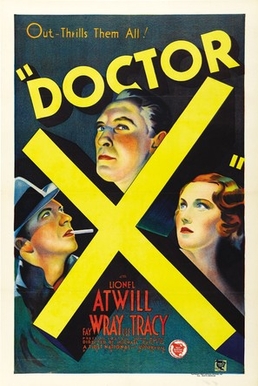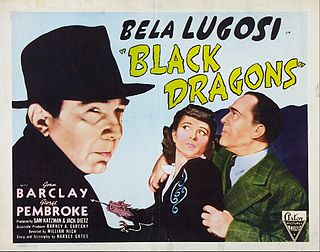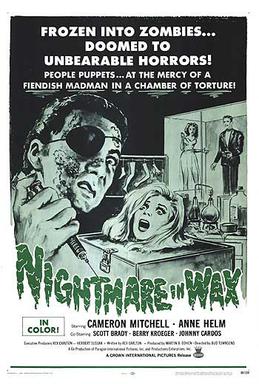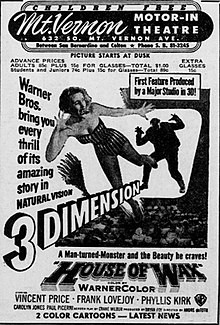
Béla Ferenc Dezső Blaskó, known professionally as Bela Lugosi, was a Hungarian–American actor, best remembered for portraying Count Dracula in the 1931 horror classic Dracula, Ygor in Son of Frankenstein (1939) and his roles in many other horror films from 1931 through 1956.

Bride of the Monster is a 1955 American independent science fiction horror film, co-written, produced and directed by Edward D. Wood Jr., and starring Bela Lugosi and Tor Johnson with a supporting cast featuring Tony McCoy and Loretta King.

"The Murders in the Rue Morgue" is a short story by Edgar Allan Poe published in Graham's Magazine in 1841. It has been described as the first modern detective story; Poe referred to it as one of his "tales of ratiocination".
Robert Florey was a French-American director, screenwriter, film journalist and actor.
3D films are motion pictures made to give an illusion of three-dimensional solidity, usually with the help of special glasses worn by viewers. They have existed in some form since 1915, but had been largely relegated to a niche in the motion picture industry because of the costly hardware and processes required to produce and display a 3D film, and the lack of a standardized format for all segments of the entertainment business. Nonetheless, 3D films were prominently featured in the 1950s in American cinema, and later experienced a worldwide resurgence in the 1980s and 1990s driven by IMAX high-end theaters and Disney-themed venues. 3D films became increasingly successful throughout the 2000s, peaking with the success of 3D presentations of Avatar in December 2009, after which 3D films again decreased in popularity. Certain directors have also taken more experimental approaches to 3D filmmaking, most notably celebrated auteur Jean-Luc Godard in his film Goodbye to Language.
House of Wax may refer to:

House of Wax is a 2005 slasher film directed by Jaume Collet-Serra, in his feature directorial debut, and written by Chad Hayes and Carey W. Hayes. The film stars Elisha Cuthbert, Chad Michael Murray, Brian Van Holt in a dual role, Paris Hilton, Jared Padalecki, Jon Abrahams, and Robert Ri'chard. It is a loose remake of the 1953 film of the same name, itself a remake of the 1933 film Mystery of the Wax Museum, based on the story "The Wax Works" by Charles S. Belden. The film soundtrack features music by Deftones, My Chemical Romance, and Interpol.

Igor, or sometimes Ygor, is a stock character, a sometimes hunch-backed laboratory assistant to many types of Gothic villains or as a fiendish character who assists only himself, the latter most prominently portrayed by Bela Lugosi in Son of Frankenstein (1939) and The Ghost of Frankenstein (1942). He is familiar from many horror films and horror film parodies. He is traditionally associated with mad scientists, particularly Victor Frankenstein, although Frankenstein has neither a lab assistant nor any association with a character named Igor in the original Mary Shelley novel. The Igor of popular parlance is a composite character, based on characters created for the Universal Studios film franchise. In the first Frankenstein film (1931), Fritz served the role; in subsequent sequels, a different physically deformed character, Ygor, is featured, though Ygor is not an assistant in those films.

The Black Cat is a 1934 American pre-Code horror film directed by Edgar G. Ulmer and starring Boris Karloff and Béla Lugosi. It was Universal Pictures' biggest box office hit of the year, and was the first of eight films to feature both Karloff and Lugosi. In 1941, Lugosi appeared in a comedy horror mystery film with the same title, which was also named after and ostensibly "suggested by" Edgar Allan Poe's short story.

Mystery of the Wax Museum is a 1933 American pre-Code mystery-horror film directed by Michael Curtiz and starring Lionel Atwill, Fay Wray, Glenda Farrell, and Frank McHugh. It was produced and released by Warner Bros. and filmed in two-color Technicolor; Doctor X and Mystery of the Wax Museum were the last two dramatic fiction films made using this process.

Hazel Court was an English actress. She is known for her roles in British and American horror films during the 1950s and early 1960s, including Terence Fisher's The Curse of Frankenstein (1957) and The Man Who Could Cheat Death (1959) for Hammer Film Productions, and three of Roger Corman's adaptations of Edgar Allan Poe stories for American International Pictures: The Premature Burial (1962), The Raven (1963) and The Masque of the Red Death (1964).

The Raven is a 1935 American horror film directed by Louis Friedlander and starring Boris Karloff and Béla Lugosi. Billed as having been "suggested by" Edgar Allan Poe's 1845 poem of the same title, excerpts of which are quoted at a few points in the film, it was adapted from an original screenplay by David Boehm. Lugosi stars as a neurosurgeon obsessed with Poe who has a torture chamber in his basement, and Karloff plays an escaped murderer on the run from the police who Lugosi manipulates into doing his dirty work.

The Corpse Vanishes is a 1942 American mystery horror film starring Bela Lugosi, directed by Wallace Fox, and written by Harvey Gates. Lugosi portrays a mad scientist who injects his aging wife with fluids from virginal young brides in order to preserve her beauty. Luana Walters as a journalist and Tristram Coffin as a small-town doctor investigate and solve the disappearances of the brides. The film was produced and distributed by Monogram Pictures, and was reissued in 1949 by Favorite Films Corporation.

Murders in the Rue Morgue is a 1932 American horror film directed by Robert Florey, based on Edgar Allan Poe's 1841 short story "The Murders in the Rue Morgue". The plot is about Doctor Mirakle, a carnival sideshow entertainer and scientist who kidnaps Parisian women to mix their blood with that of his gorilla, Erik. As his experiments fail because of the quality of his victims' blood, Mirakle meets with Camille L'Espanye, and has her kidnapped and her mother murdered, leading to suspicion falling on Camille's fiance, Pierre Dupin, a medical student who has already become interested in the earlier murders.

Doctor X is a 1932 American pre-Code mystery horror film produced jointly by First National and Warner Bros. Based on the 1931 play originally titled The Terror by Howard W. Comstock and Allen C. Miller, it was directed by Michael Curtiz and stars Lionel Atwill, Fay Wray and Lee Tracy.

Black Dragons is a 1942 American film directed by William Nigh and starring Bela Lugosi, Joan Barclay, and George Pembroke. The cast includes Clayton Moore, who plays a handsome detective. The Black Dragon Society also appears in Let's Get Tough! a 1942 East Side Kids film made by the same team of writer Harvey Gates and producer Sam Katzman.

Nightmare in Wax is a 1969 horror film. Cameron Mitchell plays Vincent Renard, a former film special effects artist who is disfigured by Max Block, the head of Paragon Pictures, and also a rival for the affections of a woman. Leaving the film industry, Vince becomes a recluse and opens a wax museum. Within a few months, four popular Paragon stars disappear. Wax figures of the missing stars soon feature as wax models in the museum and the police become suspicious.

The Brute Man is a 1946 American horror thriller film starring Rondo Hatton as the Creeper, a murderer seeking revenge against the people he holds responsible for the disfigurement of his face. Directed by Jean Yarbrough, the film features Tom Neal and Jan Wiley as a married pair of friends the Creeper blames for his deformities. Jane Adams also stars as a blind pianist for whom the Creeper tries to raise money for an operation to restore her vision.
Phantom of the Rue Morgue is a 1954 American mystery horror film directed by Roy Del Ruth and starring Karl Malden, Claude Dauphin and Patricia Medina. The film is an adaptation of Edgar Allan Poe's 1841 short story The Murders in the Rue Morgue.

The Other is a German horror punk band formed in Cologne in 2002. The band's music style blends elements of punk rock and heavy metal, with lyrics and stage costumes inspired by horror fiction and films. Although most of their material is in English, they also write and perform songs in German.

















